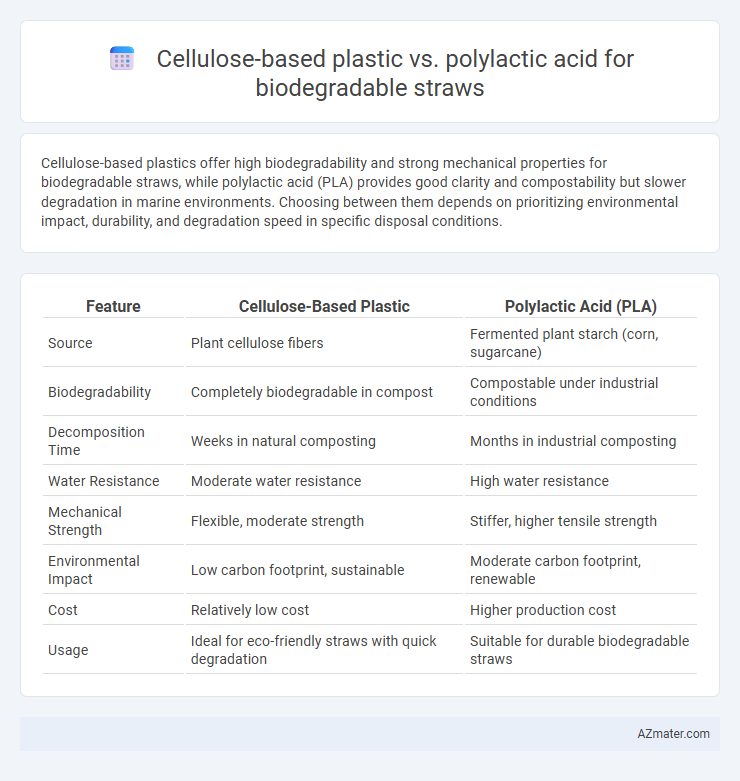Cellulose-based plastics offer high biodegradability and strong mechanical properties for biodegradable straws, while polylactic acid (PLA) provides good clarity and compostability but slower degradation in marine environments. Choosing between them depends on prioritizing environmental impact, durability, and degradation speed in specific disposal conditions.
Table of Comparison
| Feature | Cellulose-Based Plastic | Polylactic Acid (PLA) |
|---|---|---|
| Source | Plant cellulose fibers | Fermented plant starch (corn, sugarcane) |
| Biodegradability | Completely biodegradable in compost | Compostable under industrial conditions |
| Decomposition Time | Weeks in natural composting | Months in industrial composting |
| Water Resistance | Moderate water resistance | High water resistance |
| Mechanical Strength | Flexible, moderate strength | Stiffer, higher tensile strength |
| Environmental Impact | Low carbon footprint, sustainable | Moderate carbon footprint, renewable |
| Cost | Relatively low cost | Higher production cost |
| Usage | Ideal for eco-friendly straws with quick degradation | Suitable for durable biodegradable straws |
Introduction to Biodegradable Straws
Biodegradable straws made from cellulose-based plastics offer a natural and renewable alternative to traditional petroleum-based plastics, leveraging plant fibers that break down efficiently in composting environments. Polylactic acid (PLA), derived from fermented plant starch like corn, provides a transparent, sturdy, and compostable option with relatively faster degradation in industrial compost facilities. Both materials contribute to reducing plastic pollution, but cellulose-based plastics excel in environmental compatibility due to their organic fiber content, while PLA is noted for its mechanical strength and clarity.
Overview of Cellulose-Based Plastics
Cellulose-based plastics are derived from natural cellulose fibers found in plant cell walls, offering excellent biodegradability and mechanical strength for sustainable straw production. These plastics decompose efficiently in composting conditions, significantly reducing environmental impact compared to conventional plastics. Their renewable origin and compatibility with existing manufacturing processes make cellulose-based plastics a promising alternative for eco-friendly biodegradable straws.
Understanding Polylactic Acid (PLA)
Polylactic acid (PLA) is a biodegradable thermoplastic derived from renewable resources such as corn starch or sugarcane, commonly used in the production of eco-friendly straws. Its molecular structure allows for efficient composting under industrial conditions, breaking down into carbon dioxide and water within months. PLA straws offer superior clarity and rigidity compared to cellulose-based plastics, but require specific composting facilities to fully degrade, limiting their effectiveness in typical waste streams.
Raw Materials and Manufacturing Processes
Cellulose-based plastics for biodegradable straws primarily rely on wood pulp or cotton fibers, which undergo processes like cellulose extraction, purification, and chemical modification to enhance durability and flexibility. Polylactic acid (PLA) production involves fermenting renewable resources such as corn starch or sugarcane into lactic acid, followed by polymerization to form bioplastic polymers suitable for straw manufacturing. While cellulose plastics leverage naturally abundant cellulose with relatively simple processing, PLA requires fermentation and polymerization, resulting in distinct energy inputs and resource dependencies influencing their environmental profiles.
Biodegradability and Environmental Impact
Cellulose-based plastic biodegrades rapidly through microbial activity, breaking down into natural components within months in industrial composting or soil environments, minimizing environmental persistence. Polylactic acid (PLA) requires specific conditions such as industrial composting facilities to degrade efficiently, often taking longer to fully break down, which can limit its biodegradability in natural settings. The environmental impact of cellulose-based plastics is generally lower due to their renewable origin from plant fibers and faster degradation, whereas PLA's production relies on agricultural resources and may have a higher carbon footprint despite being compostable under controlled conditions.
Mechanical Properties and Durability
Cellulose-based plastics exhibit high tensile strength and flexibility, making them resistant to cracking under stress, which enhances their durability in biodegradable straw applications. Polylactic acid (PLA) offers good stiffness and hardness but tends to be more brittle and prone to mechanical degradation, reducing its lifespan under repeated use. The superior mechanical resilience of cellulose-based plastics often translates to longer-lasting straws, while PLA requires careful formulation to improve impact resistance and durability.
Safety and Food Contact Regulations
Cellulose-based plastics for biodegradable straws are generally recognized as safe (GRAS) by the FDA and comply with EU food contact regulations due to their natural polymer origin and minimal chemical additives. Polylactic acid (PLA) also meets FDA and EU standards for food contact materials but may raise concerns regarding residual monomers and additives, requiring thorough migration testing to ensure safety. Both materials must adhere to strict limits on heavy metals, volatile compounds, and overall migration to maintain compliance with global food safety regulations.
Consumer Experience: Taste and Performance
Cellulose-based plastic straws offer a neutral taste profile, minimizing any flavor interference during beverage consumption, which enhances overall consumer satisfaction. Polylactic acid (PLA) straws may impart a slight vegetal taste, especially in hot drinks, potentially affecting the flavor experience for sensitive users. In terms of performance, cellulose-based straws demonstrate superior durability and resistance to sogginess, maintaining structural integrity longer than PLA alternatives under various drinking conditions.
Cost Analysis and Market Availability
Cellulose-based plastics generally exhibit lower production costs than polylactic acid (PLA) due to the abundant availability of cellulose from agricultural residues, making them economically attractive for biodegradable straw manufacturing. Polylactic acid, derived from fermenting renewable sugars, incurs higher raw material and processing expenses but benefits from established supply chains and scalability in commercial markets. Market availability favors PLA in regions with strong bioplastic infrastructure, while cellulose-based straws are gaining traction in niche segments aiming for cost-effective and sustainable alternatives.
Future Trends and Innovations in Biodegradable Straws
Cellulose-based plastics and polylactic acid (PLA) dominate the biodegradable straw market, with cellulose offering superior natural fiber integration and PLA providing excellent compostability from renewable resources. Future trends emphasize enhancing mechanical strength and reducing production costs through bioengineering and advanced enzymatic treatments. Innovations focus on hybrid materials combining cellulose and PLA to optimize biodegradability, durability, and environmental impact, catering to growing consumer demand for sustainable alternatives.

Infographic: Cellulose-based plastic vs Polylactic acid for Biodegradable straw
 azmater.com
azmater.com